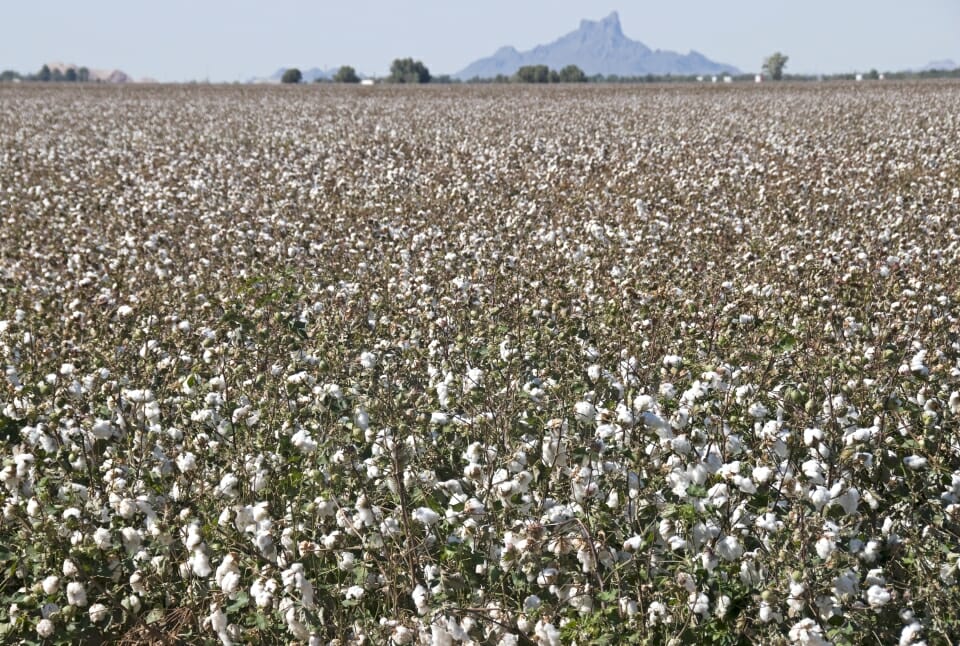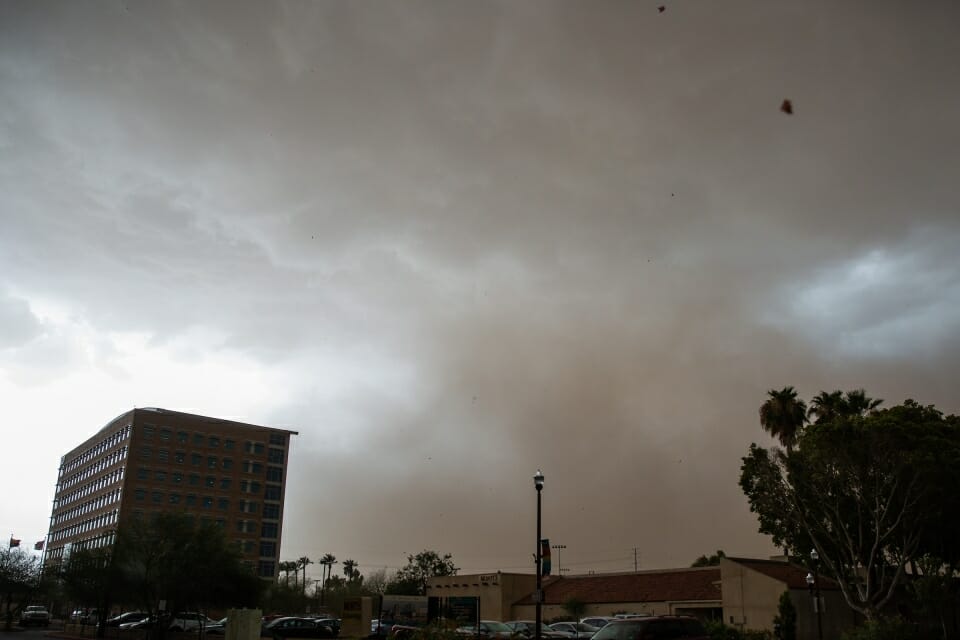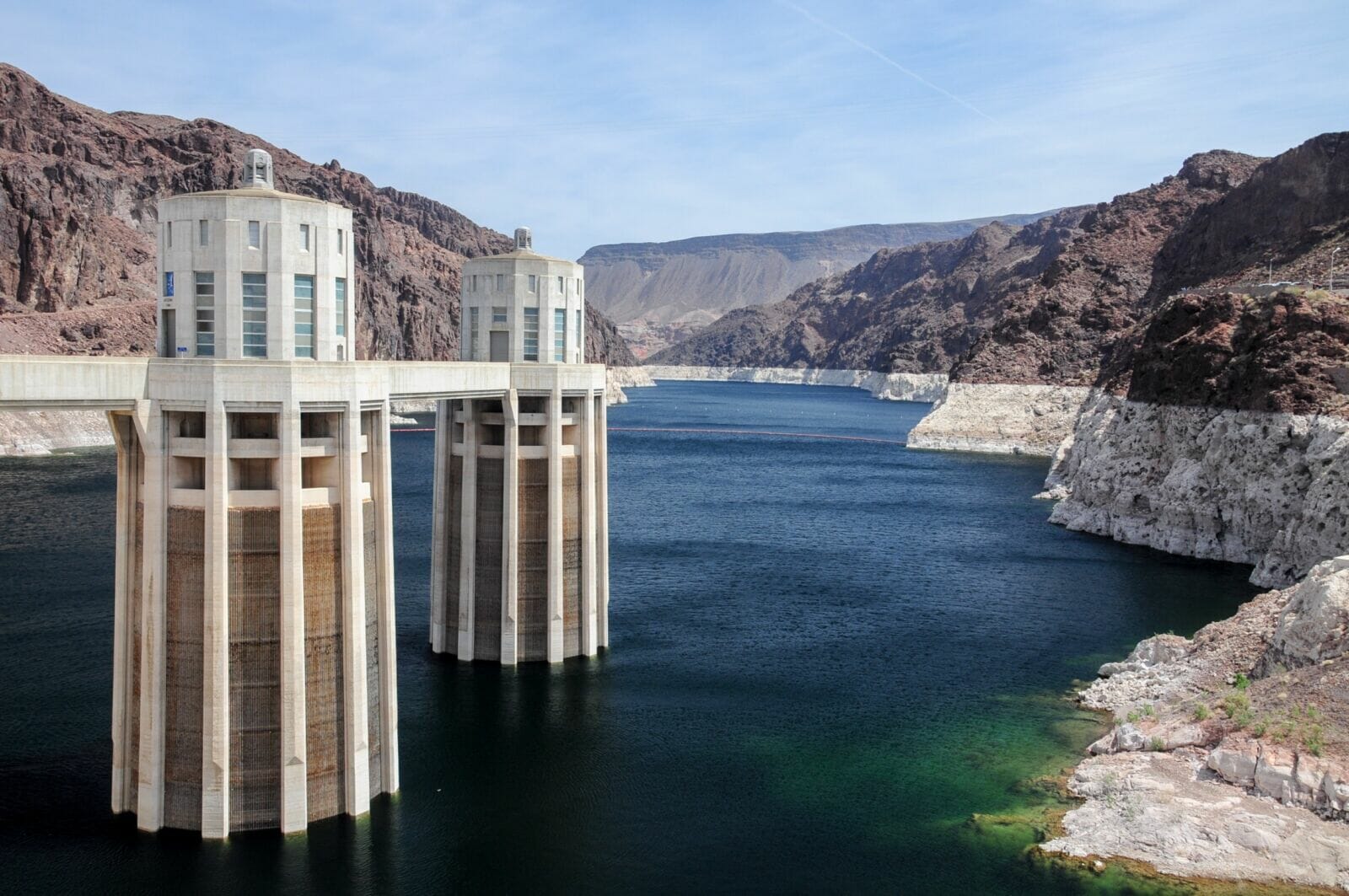The landscape at Lake Mead in Arizona looks apocalyptic. Drastically lowered water levels that have left a “bathtub ring” around the perimeter and uncovered junk that was thrown into the reservoir decades ago have changed the ecosystem and impacted the tourism industry. Does that illustrate the future of water in Arizona?
Will the Valley of the Sun face the same fate?
Climate change has produced a megadrought that has reduced water in the Colorado River, which was already overallocated to the seven states in its basin. Cuts in the water allotments were imposed in 2022, and this summer, the federal government increased those cuts. Arizona will lose about one-fifth of its share.
THE SERIES: This is the third in a three-part series examining water in the Southwest in recognition of the 100th anniversary of the Colorado River Compact. Read the first installment on the history of the Colorado Water Compact and the second installment on what it means for cities, agriculture and the individual.
READ ALSO: Some fast facts to know about the Arizona water supply
The Colorado River supplies about 36% of Arizona’s water. Other water sources come from: groundwater, 41%; in-state rivers, 18%, and reclaimed water, 5%, according to the Kyl Center for Water Policy at Arizona State University.
ASU’s experts on water don’t have a crystal ball, but their deep expertise leads them to predict definite changes to our environment and lifestyle. The amount of change depends on Arizonans’ willingness to make hard choices.
Here are some of our experts’ opinions on what we might see in the future, based on the science of today.
Arizona’s ‘Five Cs’ are climate, copper, citrus, cattle and cotton; with water restrictions, will we still grow cotton?
Agriculture is the biggest user of water in Arizona and will likely be the biggest source of cuts.
“In the whole Colorado basin, agriculture uses 75% to 80% of the water,” said Sarah Porter, director of the Kyl Center for Water Policy, which is part of the Morrison Institute for Public Policy at ASU.
The rest is consumed almost entirely by cities, which cannot reduce their use enough to compensate for the upcoming cuts.
“So it will fall to agriculture just as a numbers issue,” she said.
But what that will look like is uncertain. The biggest crops in Arizona, according to the U.S. Department of Agriculture, are alfalfa, at about 305,000 acres; cotton, 130,000 acres; corn, 95,000 acres; lettuce, 64,000 acres, and wheat, 53,000.
Agriculture is a $23 billion industry in Arizona and dates back hundreds of years. The Akimel O’odham people grew cotton a thousand years ago, and nearly 60% of Arizona’s farmers today are Native American.

Change is already happening. A recent survey about the drought by the American Farm Bureau Federation of more than 650 farmers in 15 Western states found that 74% saw a reduction in harvests and 42% switched crops. Among Arizona respondents, 40% removed orchard trees or other multi-year crops because of water restrictions.
Dave White, a sustainability scientist at ASU, expects a combination of changes in agriculture, including shrinking farmland.
“It may include different crop choices, as well as different approaches to agriculture and considering which areas of the state geographically are best suited to agriculture and which types of agriculture that the state wants to promote,” said White, who is associate vice president for research advancement at ASU, as well as director of the Global Institute of Sustainability and Innovation in the Julie Ann Wrigley Global Futures Laboratory.
“We are seeing some transitions, for example, in central Arizona, particularly in Pinal County, away from some areas of irrigated agriculture, where the water supply and water rights are not as available as they have been in the past.
“So we are very likely going to see a decline in the total acreage of agriculture in Pinal County,” White said.
One example of this transition is a pilot program launched by Bridgestone Americas, the tire manufacturer, which has paid a farmer in Pinal County to switch from alfalfa to growing guayule, a shrub used to produce rubber that is estimated to use 15% less water. Bridgestone, which has a research center in Mesa, won a federal grant to explore the growing of guayule as a more sustainable form of natural rubber.
Kathleen Merrigan, executive director of the Swette Center for Sustainable Food Systems at ASU, was the U.S. deputy secretary and chief operating officer of the U.S. Department of Agriculture before coming to ASU.
“In terms of the large-scale vegetable production that goes on in parts of our state, alfalfa production, which is a very, very thirsty crop, and cotton, also thirsty — these operations are at risk,” she said.
Merrigan said that in 2012, when she was with the USDA, the agency changed its crop hardiness zone maps, which advise growers.
“We know that with climate change, things are accelerating,” she said.
“So maybe down the road, Arizona will be growing different things than we are now. And they’ll be growing different things in North Dakota than they are now. Maybe everything shifts.”
Will our diet change?
Merrigan said that the water cutbacks could eventually affect what’s on our plates.
“Our government-issued dietary guidelines for Americans say that we should all be eating half a plate of fruits and vegetables,” she said.
In reality, few of us do that. But what if we do?
“Where in the world are those fruits and vegetables going to come from? They’re going to be imported. They may not be produced as safely. They may be produced using pesticides that we don’t allow here in the United States for toxicology reasons.”
Long term, researchers are working on whether we can eat some crops that haven’t traditionally been consumed, Merrigan said.
“Maybe we’ll have chefs that are going to figure out all kinds of additional delicious dishes that we’re going to want to eat from that.”
Will we still have pools and lawns?
Probably, but maybe not in every yard. White sees more community pools and communal green spaces as a way to reduce water demand.
“No one individual decision can move the needle on our significant water challenges in the state, but the collection of many individual decisions can help to reduce overall water demand,” he said.
About 93% of the water that is flushed or goes down the drain is reused, so there’s pressure to reduce water use outdoors, Porter said.
“In fact, I’ve been doing research on how much water grass uses. I now look at a lawn as a body of water,” she said, noting that lawns and pools use similar amounts of water, especially in the summer.
Porter is particularly sad to see lawn irrigation that runs into the street.
“This water has gone through a treatment process, so a huge waste of energy and chemical inputs has occurred,” she said.
Some cities are nudging their residents to change their yards. This summer, the Clark County Commission passed an ordinance limiting residential pool sizes in the Las Vegas area to 600 square feet or less. The city of Scottsdale recently approved several incentives for its residents, increasing grass removal rebates up to $5,000 per property and increasing the rebate for in-ground pool or spa removal to $400 plus $1 per square foot of water surface area.

I have a yard with flood irrigation. Will that go away?
“You can feel OK about your flood irrigation,” Porter said. “It’s a completely different system, and it has nothing to do with the Colorado River.”
Currently in the Valley, about 22,000 Salt River Project customers have flood irrigation in their yards. A federal study found that the watershed used by SRP, though smaller than the Colorado River Basin, is much more resilient.
Over the past several decades the number of households with grass yards in Phoenix has declined from about 70%–90% in the 1980s to about 15% now, according to the Arizona Municipal Water Users Association.
“Over time there will be changes in land use, and it’s already happening that there’s less water going to flood irrigation. And then that water will be available for other kinds of uses within the SRP project lands,” Porter said.
How about golf courses?
Taylor Weiss sees the phasing out of golf courses as good for the environment all around.
“Their very role is to spend an inordinate amount of natural resources to create a perfect plain artificial surface out of living plant material,” said Weiss, an assistant professor in the environmental and resource management program at ASU and a researcher in the Arizona Center for Algae Technology and Innovation.
Plus, irrigating golf courses creates nutrient runoff into the desert.
“You’re trying to maintain a healthy green grass that absolutely 100% cannot be sustained” — a problem that also applies to non-native palm trees, he said.
Porter thinks that golf courses have to be considered in the entire context of water choices.
“Many golf courses attract tourism and are a way to import money to the community, which could be a good use of water,” she said.
“I think we will probably see some golf courses retire over time, but if we took all the golf courses and replaced them, what would we replace them with? We would probably still want some of the open-space benefit that they give us, and open space requires water. So, it’s not simple.”

What about car washing?
Porter doesn’t think car washing will go away if people do it at commercial car washes, which capture the dirty water for reuse.
“Washing your car in your driveway or your yard is a bigger waste,” she said.
Will we be drinking treated wastewater?
Porter thinks that could happen in the next 10 years.
“I would say in terms of innovation, it’s this thinking about using the same drop of water over and over again,” she said.
Cities are already treating their effluent.
“The city of Scottsdale treats their effluent to a very high standard, and they actually lightly desalinate it so that it can be delivered to golf courses, which are a big feature of the tourism economy for Scottsdale,” she said.
“And we’re seeing interest in direct potable reuse, where the water is sent to the wastewater treatment plant, treated to some high effluent standard, and then it’s sent to a drinking water treatment plant, where it’s treated to drinking water standards and delivered.”
Will we have desalination plants in the Valley?
Arizonans could potentially be drinking desalinated water — although it won’t be cheap, White said.
“Desalination is an energy-intensive, infrastructure-intensive and water-expensive solution,” he said.
“So it is an important part of the long-term portfolio of solutions, not something that’s going to address the most immediate one-, three- or five-year challenges.”
Arizona and Mexico have been talking for years about building a desalination plant in the Sea of Cortez in Mexico, Porter said. The plan is for Arizona to build and operate the plant and in exchange take some of Mexico’s share of Colorado River water.
That project, which is at least 20 years away, is estimated to cost $5 billion and produce water at about $2,000 per acre-foot — 10 times more than the water that is delivered via the Central Arizona Project.
Desalinating ocean water also produces tons of salt, which has to be disposed of carefully so it doesn’t damage the environment.
A slightly more likely scenario is building a plant in the West Valley that would desalinate brackish groundwater, which is close to the surface. This would also produce a lot of salt — and a lot of legal challenges — but the resulting water is estimated to cost $600 to $1,200 per acre-foot.
Arizona already has a de-salting plant. The Yuma De-Salting Plant was built in 1992 to treat agricultural runoff. It operated at one-third capacity for one year and then shut down because it was too expensive. As a test, it was restarted for about a year in 2010, treating more than 9 billion gallons of water. The plant could be reactivated, with resulting water poured into the Colorado River, but it would also produce salt.
Is less water going to mean more money out of my pocket?
Probably. The decrease in water allotments will create a cascading effect.
Experts say that water bills could increase, especially in Pinal County, and property taxes in some subdivisions could rise.
The drastic depletion of the Lake Mead and Lake Powell threaten the hydroelectricity produced at Glen Canyon Dam.
Less water can mean fewer crops, which can lead to higher food costs and less profit for farmers.
Plus, farmers in Arizona and California’s Imperial Valley want to be compensated for reducing the amount of water that they collect, Porter said. That can lead to a complicated formula. The farmers in Yuma are asking for $1,500 per acre-foot of water lost, while the ones in California want $2,300 per acre-foot.
“So all told, if we’re talking about a multi-year program, we’re talking about billions and billions of dollars. And I haven’t heard of any plan for where that money would come from,” Porter said.
Other effects are more indirect, such as increased labor or facility costs for municipalities because of poorer water quality.
Water in the canals have seen an increase in types of algae that are sticky or fibrous, clogging water plant filters, Weiss said.
“At the most extreme, six times a day, teams of four to six men are taking apart equipment that was never designed to be taken apart and put back together every day to ensure that the water can keep flowing,” he said.
“That’s not a routine issue you thought about 40 years ago while the infrastructure was put in.
“The utility passes those costs onto their users and realize their user is being told that they’re getting less water and paying more for it. So the utilities are kind of stuck between a rock and a hard place in this.”
Innovation costs money, which the water providers are loath to spend and then pass on to taxpayers and ratepayers, Weiss said.
“They are always trying to find ways to minimize, minimize, minimize costs. But how do you minimize costs? Sometimes it’s by putting the costs off until later. And that’ll come due at some point.”
What is the future of water in Arizona?
Less water could affect air quality. As water cuts require less crops, land that once grew food will lie fallow, creating dust.
“Valley fever is a fungal spore that’s found in desert soils and, in particular, in fallow fields. As there are more and more fields becoming fallow, the potential for this fungal spore to enter the air is increasing,” Weiss said.
Inhaling the spores can lead to lung infection in some people and serious illness in immunocompromised people.

But we’re not talking about a nuclear-level disaster, right?
Not a disaster, no. But a complication, yes.
Palo Verde Generating Station, built west of Phoenix in 1976, is the only nuclear plant in the world that is not adjacent to a large water source, like a river or ocean. The three reactors are cooled by 23 billion gallons of treated wastewater piped along 36 miles of concrete pipeline every year from the city of Phoenix and surrounding communities.
What if cities want to divert that wastewater to be treated and reused in homes?
If the effluent suddenly stopped flowing, it wouldn’t present a safety hazard. The plant can safely shut down without it.
But the plant is now investigating ways to consume less water, such as re-treating water it has used once or finding a way to reduce evaporation.
Will less water mean less building?
Not necessarily. For one thing, household water use has declined so much that while the population of Maricopa, Pinal and Pima counties has increased 45% over the past 20 years, water use has increased only 14%, according to the Kyl Center for Water Policy’s Water Blueprint.
Also, every municipality has its own water profile. Some rely more heavily on Colorado River water than others. And some places have been factoring a decreased water supply into their planning for years.
Porter is eager to bust myths about development.
“The two biggest things that people say that are wrong are that no one has any business farming in the desert and that population growth is the reason for the water supply issues.
“It’s much more complicated than that.”
Will this crisis force scientists to innovate amazing solutions?
There have already been technological advances to make Arizona farming more water efficient — genetically modified crops that are more tolerant of drought or saline, better pesticide management, laser leveling of fields to improve irrigation and advancements in watering systems.
Globally, researchers are working on technologies to capture water from the atmosphere and desalinate at a small scale.
And technology will be harnessed to monitor the river. White is involved in a research project with NASA and the Central Arizona Project to combine satellite data with hydrological models to improve management of water allocations.
“We will have a finer-grain, more spatially explicit understanding of how climate change and other factors like forest management practices are going to affect the availability of surface water in different areas of the Colorado River Basin,” he said.
But Weiss thinks that technology alone won’t solve the water crisis.
“Sometimes it’s not a scientific problem, it’s a human problem,” he said.
“I have anxiety when governance doesn’t do anything, hoping and wishing that a magical solution will be formed sometime in the future.
“It’s kicking the can down the road and asking for science to create more solutions because they say, ‘We can’t afford the solution.’ ”
What if it rains a lot and the river fills back up?
It won’t.
White said that strong evidence from the National Climate Assessment and other sources shows that won’t happen.
“This is the new normal,” he said.
“We need to adjust to a more permanent situation of significantly lower water supplies from the Colorado River.”
Should we be anticipating a dystopian landscape?
Porter isn’t pessimistic. She believes that although hard choices have to be made, there’s enough water to go around.
But she does have worries. The Yuma area and the Imperial Valley, with good weather and rich soil, are logical places for farming, and water cuts will affect agriculture there.
“I worry that we might be losing important agricultural production that will have impacts on national food security and nutrition,” she said.
But Arizona’s climate problems are not as dire as other areas, she said.
“Houston is looking at ‘How do we wrangle hurricanes?’ Boston is looking at, ‘How do we build a sea wall?’
“The problem that central Arizona cities are looking at is, ‘How do we make sure we have enough water?’ And in the scale of the big challenges the different cities are looking at, this is a very solvable one. We know what the solutions are.
“So I don’t feel like there’s a good reason to not feel hopeful.”
She believes engineering and management improvements will stretch or even augment available supplies.
The Kyl Center has produced a tsunami of information and data that leaders can use to make good decisions. But they need to act.
“This is really about our commitment to good water management and knowing that it will cost money and it can sometimes mean saying no to some things. And that’s the tough part,” she said.
“It’s totally doable.”
Arizona’s water picture is much bigger than the Colorado River. For a more complete description of our water system, the complicated issues surrounding who gets the water and what might happen in the long term, visit the Arizona Water Blueprint, an interactive platform created by the Kyl Center for Water Policy at ASU.




